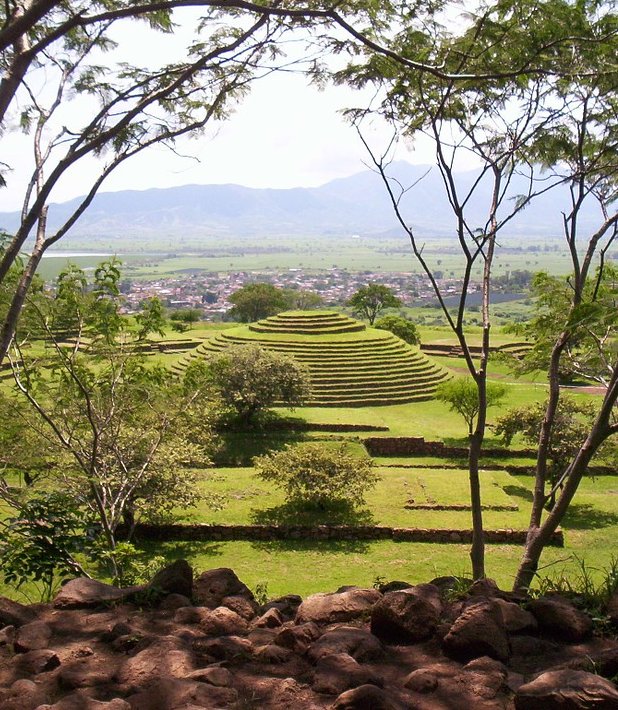Circular Stepped Pyramids Of Guachimontones And Teuchitlan Tradition – A Lost Ancient World In Mexico
A. Sutherland - AncientPages.com - A remarkable, ancient archaeological site Guachimontones (‘Los Guachimontones’) is located just outside the modest little town of Teuchitlán, Jalisco, 43 kilometers (26 miles) west of Guadalajara, Mexico.
At first, very little was known about who had built this remarkable place with rounded pyramids, several conical mounds or pyramids, terraced patios surrounded by circular ball games, an amphitheater, some terraces, buildings, and sophisticated ancient shaft tombs. Dating to the first centuries A.D., these tombs had small burial chambers at the bottom of vertical cuts up to 60 feet deep.
 Los Guachimontones. The dominant features at los Guachimontones are circular stepped pyramids in the middle of circular building complexes. The 60-foot (18 m) tall pyramid at Circle 2 has 13 high steps leading to an upper level, which was then topped with another 4 high steps. One of the most impressive archeological sites in all of western Mexico.
Los Guachimontones. The dominant features at los Guachimontones are circular stepped pyramids in the middle of circular building complexes. The 60-foot (18 m) tall pyramid at Circle 2 has 13 high steps leading to an upper level, which was then topped with another 4 high steps. One of the most impressive archeological sites in all of western Mexico.
The site was discovered by the late U.S. archaeologist Phil Weigand in 1970 and today, it is among the most visited archaeological sites in the country.
Weigand spent 29 years documenting a complex, highly organized society that had begun in western Mexico about 1000 BC and had reached its peak in 200 AD.
Guachimontones, home to approximately 40,000 people, was built by a unique culture, known as Teuchitlán Tradition, one of the pre-Hispanic cultures that flourished in western Mexico.
 Image credit: Esteban Tucci - CC BY-SA 3.0
Image credit: Esteban Tucci - CC BY-SA 3.0
Inhabitants of the city created small agricultural islands irrigated by an ingenious system of floodgates, dams, and canals and they traded in salt from the flats of the Sayula Basin of central Jalisco.
The city’s geographical location was certainly of great importance for the Teuchitlán tradition because these people lived right next to the third largest obsidian deposits in the world.
In fact, they controlled more than 1,000 obsidian mines, from which some 14,000 tons of the precious volcanic glass were extracted. Skilled craftsmen in Teuchitlán's workshops shaped the obsidian into swords, spearheads, mirrors of extraordinary quality, and unique, ultra-thin earrings.
The city’s geographical location was certainly of great importance for the Teuchitlán tradition because these people lived right next to the third largest obsidian deposits in the world.
However, the dominant features at los Guachimontones are circular stepped pyramids in the middle of circular building complexes.
According to Weigand, these structures, set in concentric layers of stone and turf, are not only unique in Mesoamerica but also not found anywhere else in the world.
Their cover is huge, with at least three such pyramids, and stone platforms for temples around them.
These so-called Circles of Guachimontones predate the Incas and Aztecs and lack any Olmec influence.
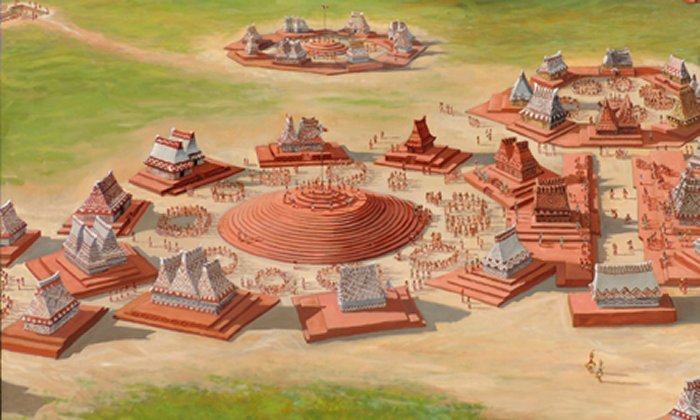 Artist recreation of Los Guachimontones. From Beekman and Pickering (2016). Image credit: Herb Roe - CC BY-SA 4.0
Artist recreation of Los Guachimontones. From Beekman and Pickering (2016). Image credit: Herb Roe - CC BY-SA 4.0
The structures are unique in that they are based on concentric circles, not any kind of pyramid.
The main structure was built on a hilltop and used as a ceremonial site to worship the deity Ehecatl-Quetzalcoatl, a feathered serpent worshiped as the god of wind in many pre-Hispanic civilizations across Mexico.
Credit: Public Domain
It has 52 steps, corresponding to the number of weeks in a year and the number of years in the cycle of many Mesoamerican calendars, including the infamous Mayan calendar.
The site is also home to several rectangular platforms and two ball courts, commonly known in many Mesoamerican cultures, with competitors typically using their hips to somehow control the ball and move it from one end of the court to the other, and in some cases pass it through a ring.
Written by – A. Sutherland AncientPages.com Staff Writer
Copyright © AncientPages.com All rights reserved. This material may not be published, broadcast, rewritten or redistributed in whole or part without the express written permission of AncientPages.com
Expand for referencesMore From Ancient Pages
-
 Viking Grave Discovered In The Middle Of Oslo, Norway
Archaeology | Dec 23, 2022
Viking Grave Discovered In The Middle Of Oslo, Norway
Archaeology | Dec 23, 2022 -
 Mysterious Skeleton Of Unusual Lady Anchoress Of York Barbican Discovered By Archaeologists
Archaeology | Feb 7, 2023
Mysterious Skeleton Of Unusual Lady Anchoress Of York Barbican Discovered By Archaeologists
Archaeology | Feb 7, 2023 -
 Evidence Of An Advanced Ancient Civilization In Texas That Mysteriously Disappeared
Ancient Mysteries | Jul 18, 2024
Evidence Of An Advanced Ancient Civilization In Texas That Mysteriously Disappeared
Ancient Mysteries | Jul 18, 2024 -
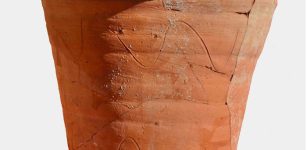 Ancient Roman Portable Toilets Studied By Scientists
Archaeology | Feb 11, 2022
Ancient Roman Portable Toilets Studied By Scientists
Archaeology | Feb 11, 2022 -
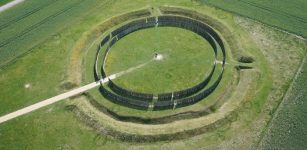 New Study: Middle Neolithic Circular Enclosure Of Goseck – Sacred Place And Astronomical Observatory
Archaeology | Aug 9, 2023
New Study: Middle Neolithic Circular Enclosure Of Goseck – Sacred Place And Astronomical Observatory
Archaeology | Aug 9, 2023 -
 Rapa Nui’s Population: Growth And Decline – Lesson For Our Future?
News | Sep 4, 2020
Rapa Nui’s Population: Growth And Decline – Lesson For Our Future?
News | Sep 4, 2020 -
 Manasota People: Will 1,300-year-Old Village Tell Us About Their Lives?
Archaeology | Jan 11, 2016
Manasota People: Will 1,300-year-Old Village Tell Us About Their Lives?
Archaeology | Jan 11, 2016 -
 What Happened To The Ancient Tribe That Entered A Secret Underground World And Never Came Back?
Ancient Mysteries | Feb 1, 2021
What Happened To The Ancient Tribe That Entered A Secret Underground World And Never Came Back?
Ancient Mysteries | Feb 1, 2021 -
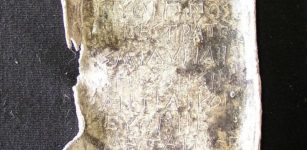 Curse Tablets With Messages To The Gods Of The Underworld Found In 2,500-Year-Old Well
Archaeology | Feb 7, 2020
Curse Tablets With Messages To The Gods Of The Underworld Found In 2,500-Year-Old Well
Archaeology | Feb 7, 2020 -
 Unknown Inscription Accidentally Found In South Tower Of 13th Century Cēsis Castle In Latvia
Archaeology | Aug 18, 2020
Unknown Inscription Accidentally Found In South Tower Of 13th Century Cēsis Castle In Latvia
Archaeology | Aug 18, 2020 -
 Archaeological Mystery – Why Has Only One Such Puzzling Ancient Object Been Found In Norway?
Ancient Mysteries | Aug 8, 2024
Archaeological Mystery – Why Has Only One Such Puzzling Ancient Object Been Found In Norway?
Ancient Mysteries | Aug 8, 2024 -
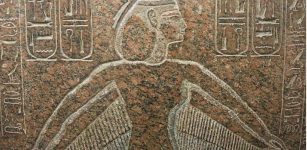 Nephthys – Egyptian Funerary Goddess Who Also Protected The Pharaohs While They Were Alive
Featured Stories | Aug 15, 2021
Nephthys – Egyptian Funerary Goddess Who Also Protected The Pharaohs While They Were Alive
Featured Stories | Aug 15, 2021 -
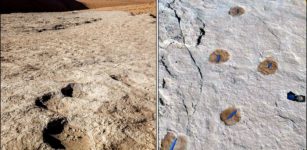 120,000-Year-Old Human Footprints Discovered In Saudi Arabia
Archaeology | Sep 18, 2020
120,000-Year-Old Human Footprints Discovered In Saudi Arabia
Archaeology | Sep 18, 2020 -
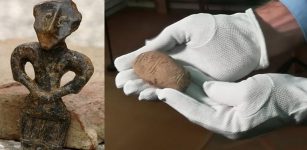 7,000-Year-Old Inscription With Undeciphered Vinca Script – One Of The World’s Earliest Writing Systems Discovered
Archaeology | Feb 17, 2018
7,000-Year-Old Inscription With Undeciphered Vinca Script – One Of The World’s Earliest Writing Systems Discovered
Archaeology | Feb 17, 2018 -
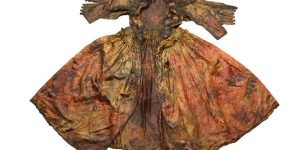 Unique 17th Century Silk Dress Found At Bottom Of The Wadden Sea Goes On Display
Artifacts | Jul 29, 2023
Unique 17th Century Silk Dress Found At Bottom Of The Wadden Sea Goes On Display
Artifacts | Jul 29, 2023 -
 Ancient Mesopotamian City Lagash Reveals More Archaeological Secrets
Archaeology | Jan 25, 2023
Ancient Mesopotamian City Lagash Reveals More Archaeological Secrets
Archaeology | Jan 25, 2023 -
 What Was Humor Like In The 13th Century?
Featured Stories | Jun 22, 2018
What Was Humor Like In The 13th Century?
Featured Stories | Jun 22, 2018 -
 Divine Shulgi Of Ur: Influential, Long-Ruling King, Conqueror And Native Akkadian Speaker In Five Languages
Civilizations | Mar 22, 2019
Divine Shulgi Of Ur: Influential, Long-Ruling King, Conqueror And Native Akkadian Speaker In Five Languages
Civilizations | Mar 22, 2019 -
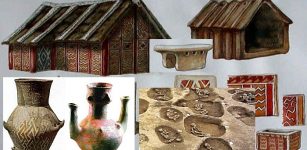 Lengyel Culture Of Neolithic Europe Was Amazingly Sophisticated
Civilizations | Apr 7, 2020
Lengyel Culture Of Neolithic Europe Was Amazingly Sophisticated
Civilizations | Apr 7, 2020 -
 Darabgerd: One Of The Oldest Cities Dated To Achaemenid Era
Featured Stories | Jan 28, 2021
Darabgerd: One Of The Oldest Cities Dated To Achaemenid Era
Featured Stories | Jan 28, 2021


